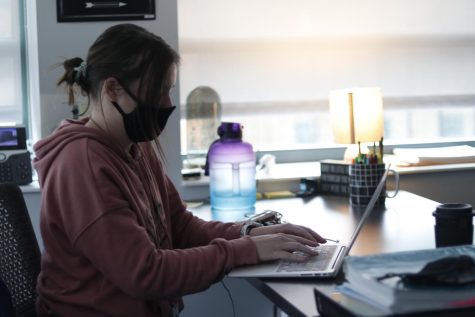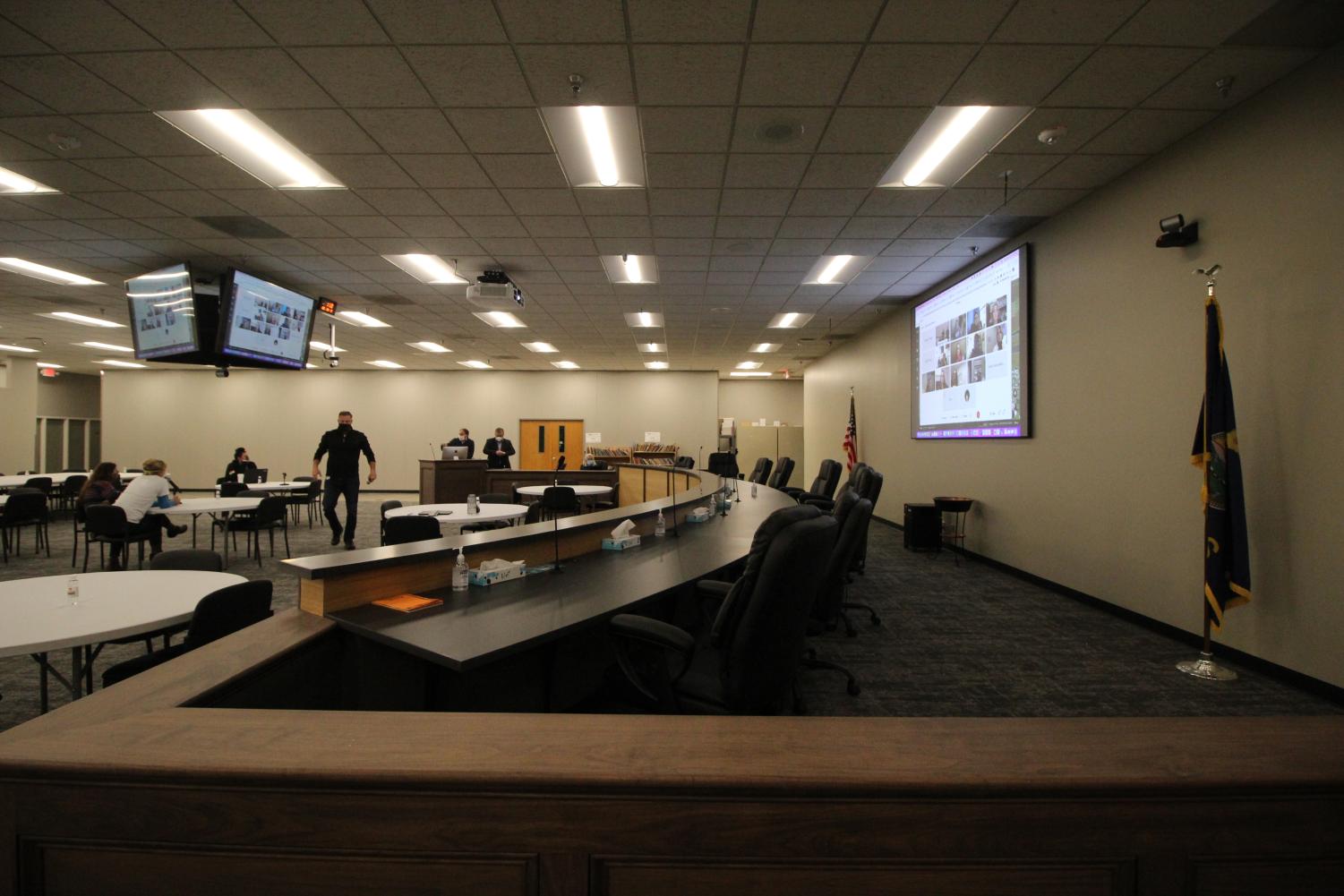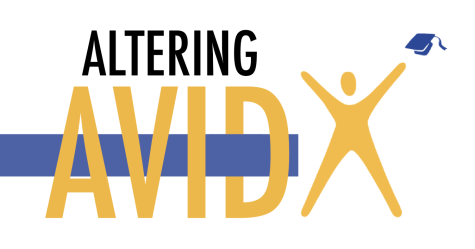Amid budget deficit, school board weighs options
Between the complicated logistical talk and controversial changes, what's going on with USD 497’s budget for 2022-23?
March 22, 2022
BY JACK RITTER
What put the district’s budget in this position of shortfall and imbalance?
Lack of Reserve Funds
Under Gov. Sam Brownback, the state of Kansas saw decreases in educational funding every year from 2011 to 2018, school board vice president Shannon Kimball said during a Feb. 14 board meeting. As a result, the district dipped into reserve funds. The one-time money was used to raise teacher salaries and maintain operations.
With reduced state funding, the district turned inward to reserve funds, or one-time money. Year in and year out, the district dipped into its reserves to meet its needs at the time.
Now, in a budgeting crisis, USD 497 cannot turn inward to solve issues and shortfalls.
Declining Enrollment
The biggest factor contributing to recent decreases in enrollment is the global pandemic of COVID-19. As enrollment dropped — a trend seen statewide — the district received less money.
Zachary Conrad, the district’s executive director of research and evaluation, has explained that several factors play into the decrease. Among the issues is a decline in county births despite increasing county population, flattening enrollment after 2015 and declining enrollment as a result of the COVID-19 pandemic.
The district lost at least 600 students between 2019 and 2021 Executive Director of Communications Julie Boyle wrote in an email to The Budget.
That loss of students would roughly amount to a $3.5 million financial deficit. However, the district has undertaken a mission to come up with $7 million. Here’s why:
Necessary Raises for Staff
Over the next two years, USD 497 plans to increase staff salaries, a long-overdue modification to the district’s budgeting. As districts across the state of Kansas and Missouri have considerably increased salaries, USD 497 has been more than reluctant to do so.
In the past few years, dozens of teachers have left Lawrence Public Schools while wages have stagnated, so USD 497 plans to change its approach.
“I wholeheartedly agree that we must do so,” school board Vice President Shannon Kimball said about raising salaries during the Jan. 24 school board meeting. “For example, I recently spoke to a teacher who left our district last year and was offered $14,000 more a year for the same job in a nearby district. Our staff has discussed seeking a 3 percent increase for the upcoming fiscal year. That adds at least another $2.5 million to the amount we must cut in our current and ongoing operations for the next fiscal year.”
“[Losing teachers] is real, and it is untenable and unsustainable for the future of the quality of education in our district,” she added.
In a board meeting previously this year, Kimball initially used a figure of $7 million which has since been the figure consistently utilized by the district. Despite objections to the figure, the board reaffirmed the number in a meeting on Feb. 14.
What does the district plan to do in response?
From January to mid-February, the school board challenged the Budget and Program Evaluation Committee (BPEC) and its various subcommittees with compiling a list of recommended cuts.
The BPEC returned to the board with three packages. Each package would save roughly $6 million or more.
However, the school board found these packages inadequate. So, the district has had its administrative team identify cuts (many already identified during BPEC meetings) and present them to the school board. From there the school board will choose which cuts to move forward with.
In early March, the administrative team began reviewing proposals, updating budgeting calculations and compiling a list of cuts.
“The board is currently using a budget planning process to identify savings,” Boyle said. “This process includes the work of the [school] board’s Budget and Program Evaluation Committee (and its nine subcommittees) and the Boundary Advisory Committee.”
On March 11, the administrative team released a list of recommended cuts that saved an estimated $6.45 million, and a few proposed cuts stick out among the rest:
- Restructuring AVID
- Reducing high school staff with previous discussions centered around sharing of staff for low enrollment classes
- Removal or restructuring of academic or athletic activities
BY FINN LOTTON-BARKER AND JACK TELL
Staff salaries have been part of discussions in the district for years, long before the budget deficit existed. For decades, students, parents and teachers have been arguing with the district and pushing for higher salaries for educators.
After making agreements with teachers’ union to raise salaries, the district added an additional $3 million goal, raising the total deficit to $7 million.
After wages were frozen last year, some staff are ecstatic that raises could finally be on the way, but others have concerns about the effects that cuts may have on classrooms.
“The education of kids is worth more than a bigger paycheck,” English teacher Bethany Anderson said. “I do think the cuts might affect the quality of education in the school district. I can’t say for certain because it’s based on the unknown right now, but I’ve seen districts have budget cuts and the outcome is really hard on the resources [that] teachers need to be effective.”
Anderson was hired at the semester to fill a vacant spot in the English department, and this is her first full-time job in the teaching industry.
“As a brand new teacher, I put in about 60 hours per week on teaching, lesson planning, grading, meeting standards, going to meetings and so much more,” she said. “Sometimes I have to remind myself that it’s OK to do things for myself.”
The pressure of the past few years has been building for all USD 497 employees, and the strains of COVID, new building complications and the budget deficit have put educators in an awkward position.
Some teachers say they feel that their voices are unheard in conversations, but they hope that they can still have an impact on decisions. For German teacher Arne Scholz, education quality is a decisive factor in these discussions, and improvements in classroom materials deserve consideration.
“I’m teaching with books that are 30 years old,” Scholz said. “Teacher compensation is not everything. I would like to have more money, but I would also like to have new textbooks for my kids. At the end of the day, a teacher’s working conditions are a student’s learning conditions.”
The school board decided on Feb.14 that school closures are completely off the table, which has made some question whether there are any feasible solutions currently on the table.
“I’m certainly happy that they’re not closing schools,” math teacher David Rush said. “But it is kind of stressful thinking that some of my colleagues might lose their jobs, or if somebody retires they might not replace them. Which would then cause more stress on those of us who are staying here, by possibly creating larger class sizes and fewer options for our students.”
In addition, many have questioned the state of the administration in regards to salaries. Many in the community have called for cuts to administrative salaries for years but significant changes are yet to be made.
“I think we are a little top-heavy in this school district,” Scholz said. “We have a lot of administrative positions that are highly paid, and my question would be, ‘Do we need all of those positions?’ ”
The district Board of Education has refuted ideas that the district is top heavy in terms of salary. During back-to-back meetings on Feb. 21 and Feb. 28, the board has compared its number of administrators to other schools.
Plateauing paraeducator pay remains a top concern. For Paul Brecht, a para at LHS, conditions for him and his peers are subpar.
“We’re bleeding,” Brecht said. “Good, caring, dedicated people are leaving the job because they can no longer see a future for themselves. For a long time in public education, the solution to each new struggle has been to demand more and more sacrifice from educators. Sacrifices to their time, stamina, wallets, and not least of all, their dignity.”
Brecht feels that the toll that is being exacted on paras is beginning to cause other widespread problems throughout the district.
“If we don’t find meaningful ways to stop the bleeding, the real casualties will be the students,” Brecht said. “We already saw what happened when strain is put on that system during the worst parts of the ongoing pandemic.”
Paras are essential to learning environments in schools, but their pay rarely reflects that. To Brecht, it’s more than just a district-level problem.
“Any time you talk about pay for educators, teachers and paras alike, you have to look at the issue top to bottom,” he said. “There are funding problems at every single level, starting from federal budgeting all the way down to local government. There is no point in that long-chain where enough consideration is given to the people who are the actual gears turning in the machine, those who make the schools run.”
A growing number of staff in USD 497 have looked elsewhere to continue their work or have left the field early because of pay.
“It’s a teacher retention reason,” Rush said. “There are teachers that are looking to leave because they can make more money if they just go 30 miles down the road. We want the best teachers here, we want the best staff here. I think it’s really difficult to keep us here if we don’t have comparable salaries to other districts in the area,”
This migration is certainly going to affect Lawrence schools in a myriad of ways, and some ramifications are already hitting the district. For example, substitute teacher shortages have been drastic throughout schools in USD 497 this year.

“It’s going to be hard on the schools in Lawrence to lose all of these amazing teachers to higher-paying jobs,” Anderson said. “Since we are in a budget crisis, it’s hard to actually act on this situation.”
As more and more teachers feel under-appreciated in their field, fewer and fewer people are inclined to enter it. Anderson has struggled with the decision to become a teacher in the face of budget issues.
“I definitely had an internal battle every day when I was going through school to become a teacher. I often wondered if the amount I was going to get paid was even worth it,” she said.
Even with the number of college kids becoming students teachers dwindling, the ones still in the field feel sure about their choice. LHS student-teacher Carrington Porter feels that her work is still just as important despite the fact that she feels teachers are unfairly treated.
“I consider teachers to be highly qualified, they have the expertise, the degree, the student teaching experience, everyone has to go through that,” Porter said. “I definitely think they are undervalued as a profession, and so absolutely I think they deserve more compensation for that.”
As the budget situation further develops, staff concerns are abundant and many people in the district feel nauseated at the prospect of navigating all of the new changes that severe budgets are bound to bring.
“I really do love teaching and I love where I am, but it is a little scary to think about the budget crisis that Lawrence is in right now,” Anderson said. “The security feels like it’s slipping away with every conversation about the crisis that we are in.”
The overarching gloomy narrative communicated by USD 497 staff is evident, but paras like Brecht say it best.
“If you are a parent of a USD 497 student,” he said, “you should absolutely be concerned about the quality of education your child is receiving because we’re in a bad spot.”
BY MAXWELL COWARDIN
Sheryl Clevenger’s agriculture classes are just a few of many courses that the district discussed combining at both high schools, but many argue that combining the classes and eliminating educators would be unfair for students.
As Clevenger told the district at a board meeting on Jan. 10, agriculture and skill-specific programs receive funding through federal programs and additional state funding for such classes. Consolidating the programs would fundamentally reduce the district’s funding, as well as negatively impact the courses themselves, she said.
“I truly think that if they consolidate the programs, it’s going to effectively kill both programs,” Clevenger said. An early proposal would have have left one agriculture teacher with students bused to either school at the end of instruction. With the time it would take them to cross town, “is that really effective instructional time or a waste?”
The agriculture classes at Lawrence High are CTE lab classes, meaning they prepare students for careers with hands-on technical training.
“It gives me a better gauge of what I would be seeing in that field. I didn’t expect a lot of the close-up details like using microscopes and folding kits,” junior Maria Pollington said.
Pollington is in the Plant and Animal Science pathway, and she wants to get involved with veterinary science and become a vet one day. Pollington praises the courses, and she admires the agriculture-based course study in addition to hands-on work.
“And we also do a lot of out-of-school activities that are really fun, and they get you more involved with the class,” she added.
The Plant and Animal Science courses at Lawrence High prepare students for careers using practical skills, technical skills and they provide a path for students looking to work in agriculture in the future.
Additionally, the combination of the programs would negatively impact LHS’ chapter of the Future Farmers of America (FFA). The Lawrence High FFA chapter was chartered in 1931 and is one of the oldest in the state. As it is, both LHS and LFSHS have separate FFA chapters, one for each school. Each chapter is required to run a program of 15 student-led and organized activities per year.
“They are supposed to be tailored to the student population and created/implemented by the students. LHS and FSHS have completely different populations, therefore different needs” Clevenger said.
When Clevenger joined the district in 2018, she was told that the agriculture program was broken and needed someone to fix it.
“And for the next two years, I wasn’t allowed to change anything,” she said.
Clevenger believes that plant and animal science has a future here at LHS, saying “had proposed revisions occurred in a timely fashion, the AG program could be reaching more students. Admitting a problem, yet denying change, has led us to this position.”
BY JACK RITTER AND JAKE SHEW
As the USD 497 Budget and Program Evaluation Committee (BPEC) deliberates on proposals to overcome its budget shortfalls, the AVID program faces potential restructuring.
In its presentation to the school board, the committee highlighted a plan to rebrand or restructure the AVID program, estimating the rebrand would result in savings of around $100,000 for the district. USD 497 executive director of communications Julie Boyle explained that the restructuring would lead to a “model of one AVID specialist per building as opposed to multiple educators.”
In addition, the proposed change would result in the creation of a new district AVID trainer position, which, Boyle explained, “could be an upfront expense meant to save external training costs long term.” The new trainer would be certified by the national AVID organization and could train AVID teachers in-house, rather than the district paying for transportation and materials for external training programs.
For AVID educators at Lawrence High like Eugene Miles, AVID provides a pathway for dreams to come true.
“I give students what I did not have in school,” he said. “Ideas and ways of seeing their future without having to use a medium. I also teach [students] to not let things prevent you from what you want to do or be in life. Use them, in order to achieve your goals.”
In Miles’ eyes, AVID paves roads previously unavailable for many.
“AVID is a program that I wish I knew about growing up,” he said. “I was the perfect candidate for AVID. It takes students that take it seriously and stay the course all four years, and it transforms them. It promotes self-advocacy, a growth mindset, it builds goals and accomplishes dreams. AVID has brought many students at LHS to the pinnacle of their dreams, and college at one point was not an option or on the table for them, is now a reality.”
Senior Helen Viloria, a long-time AVID member, also appreciates AVID’s value immensely.
“AVID was such an instrumental program for me in middle and high school,” she said. “It gave kids support and kept them accountable within school while giving a community. I also think it helped students from all different walks of life realize that higher education is valuable and attainable.”
Miles added that the AVID restructure doesn’t seem like an issue to him.
“Respectfully, reconstructing AVID looks different from all perspectives,” he said. “When I hear ‘restructure’ I think about rearranging it so that it looks different from what the original looked like. What the district has in mind, as I understand it, is not a restructuring, but a continuous practice with no plan to take AVID away. Also no plan to train any new teachers who may want to teach AVID. Meaning no Summer Institute, no training, and no new skills to learn for existing AVID teachers. This is more likely to affect teachers than students to me.”





